Sit Down, I Think I Love You (Magic Seat)
The 2018 Honda Fit is well-named. It isn’t too big, isn’t too small—it’s a good fit no matter what size the occupants are and the yawning hatch can gobble up everything from large boxes to bikes to furniture. As an added bonus, the 2018 Fit is a fuel miser with an EPA fuel economy rating of 33 mpg city/40 highway/36 combined for the base LX model with a continuously variable transmission (CVT).
What’s New For 2018
Honda didn’t make any drastic changes to the 2018 Fit. Without any glaring flaws to fix, Honda’s engineers instead focused on improving the Fit wherever they could for this mid-cycle update. The result is a great little hatchback that was made incrementally better across the board.

Under the skin, engineers went to work upgrading the suspension, steering, chassis bracing and sound deadening materials inside the doors, wheel arches, and pillars. To reduce wind noise, the new Fit received an acoustically insulating windshield and thicker front quarter-windows. All of this adds up to giving Honda’s least expensive car a more refined driving experience.
A big deal for the segment is the availability of the Honda Sensing driver aids. It includes not just forward-collision warning, automated emergency braking and lane-keeping assist, but also road-departure mitigation and adaptive cruise control. The Fit is the most affordable car in America with such a robust offering of safety and driver-assistant features and the only vehicle within its segment to do so. Honda Sensing is an option on the base LX and Sport models, standard on EX and EX-L trims.
Inside, the changes aren’t immediately noticeable, but are significant.
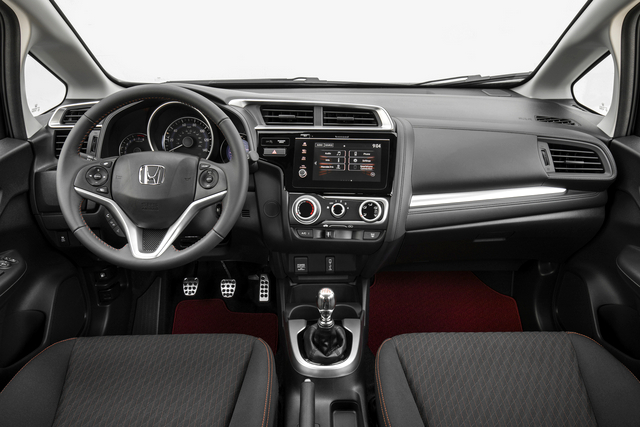
There’s a new 7.0-inch Display Audio infotainment system that comes standard on Sport, EX and EX-L models. At last, it offers Apple CarPlay and Android Auto integration. Even better, a volume control knob is back.
Also among the updates is the return of the Fit Sport model. Don’t get too excited, as it’s not actually any sportier than the rest of the lineup. The Sport is a Fit LX that gets its own unique front spoiler and rear diffuser with orange accents, side-sill extensions, black 16-inch wheels, and a chrome exhaust tip. The Sport interior is accented with orange stitching on the leather-wrapped steering wheel and shift knob, plus the upgraded audio system found in the EX and EX-L.
Refreshed Exterior and Interior
The hatchback body style is clearly the best way to maximize passenger and cargo room in small cars, and the 2018 Honda Fit is one of the more unusually proportioned examples. However, its styling serves a greater purpose than mere aesthetics.
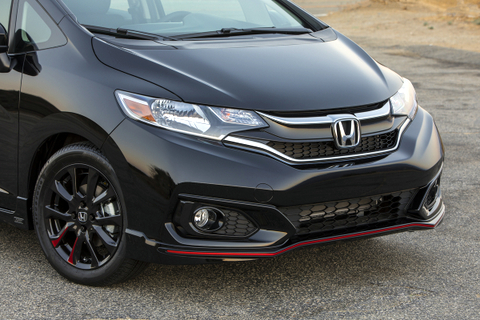
Fit has a stubby nose with a new front fascia and a more sophisticated two-piece chrome and piano black grill highlighted by slim, swept-back headlights. Its radically angled front roof pillars frame a huge windshield, and its long-roof, wagon-like body is chopped off just behind the rear wheels. Big taillights run down from the top of the hatch into the bumpers (a tribute to Volvo?), complementing a new rear fascia.
With lots of side-glass, small wheel openings, and an overall length of just 13 1⁄2 feet, the effect is a bit toy-like. But with the tall roofline and relatively generous wheelbase, Fit devotes most of its volume to cabin space.
Within is the expected Honda fit and finish with cabin materials on par with cars in the subcompact class. Our Fit Sport distinguished itself with a black interior with unique cross-hatched fabric for the seats and door trim. The exterior’s orange accent theme continued inside with bright orange stitching on the seats, console-mounted armrest, and leather-wrapped steering wheel and shift knob.
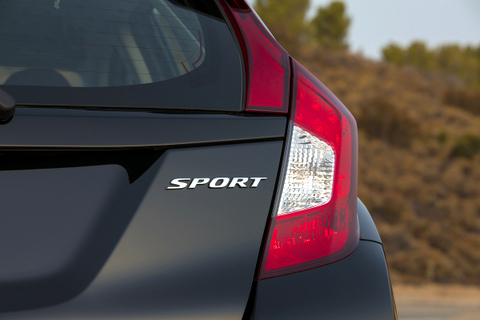
The driver faces a blue backlit instrument cluster featuring a quite large center-positioned speedometer, with a tachometer residing on the left and a multi-information display on the right. A height adjustable driver’s seat, combined with a tilt and telescoping steering column, make easy work of finding a comfortable driving position.
Tall folks will feel at home in the Fit’s front seats, where there’s ample head, leg and shoulder room for the six-foot-plus set. Rear doors open wide for easy entry and once seated, passengers will find more legroom than any car in its class.
Regardless of which model is chosen, Fit’s defining feature is Honda’s innovative “Magic Seat.” This triumph of levers and hinges allows the 60/40 split rear seatback and cushions to flip or fold in multiple configurations for hauling just about anything. Big flat screen TV? No problem. A couple of mountain bikes? Heck, yes. Eight-foot 2×4’s? Just fold the front passenger seat. OK, how about a trip to Ikea? Sure. With the rear seats flat, the maximum cargo room of 52.7 cubic feet is the subcompact leader by a lot.
Driving the 2018 Honda Sport
A few Fit rivals offer more than one engine—some are even turbocharged—but the 2018 model again relies on one naturally aspirated four-cylinder of 1.5 liters. However, it has a dual—instead of single—overhead camshaft design and the efficiency advantages of direct fuel injection. Horsepower is 130 with torque of 114 pounds-feet.
Raw speed was never the Fit’s strong suit, but power and torque put acceleration to the upper middle of the class. A sprint to 60 mph is a commendable 8.5 seconds.
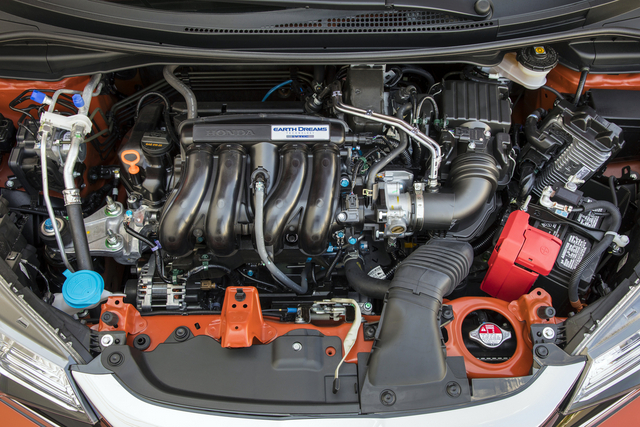
Our Fit Sport’s engine was mated to a six-speed manual transmission. Like most other Honda manuals, it’s a slick, precise gearbox that’s a joy to shift. The clutch is light and user-friendly, making stop-and-go traffic much more tolerable than it is in a lot of sportier cars.
All Fits are equipped with a MacPherson front suspension, while the rear set up is subcompact-typical—a torsion-bar design—which works nearly as well as an independent design in negotiating quick corners. Brakes are disc in front, while rear drum brakes hold costs down without imposing much negative effect on stopping distance or fade-resistance.
What the Fit lacked in power, it made up in handling. The electrically assisted rack-and-pinion steering system was communicative and responsive, easily noticed on quick transitions such as lane changes and in cornering. On sharp, switchback roads, Honda’s engineering trumps the plebeian blueprint. The car responded quickly to steering inputs and eagerly bit into corners, yielding to nose plow only on high-speed turns that revealed the limited grip of the 16-inch tires.
In-town driving was a no-muss, no-fuss affair. Power was more than adequate in suburbia. At modest speeds the suspension tackled bumps and dips in a gracious manner. Parking, either parallel or head-in, was accomplished with ease.
On the highway, the Fit Sport held a straight line with few steering wheel corrections to keep between the lines. Unlike driving on city streets, the Fit’s suspension becomes a little raw when speeds increase, particularly in encounters with pavement expansion joints. At higher freeway speeds the engine noise was markedly subdued compared to the previous edition.
However, fuel economy is most likely a higher priority than sharp handling for the typical buyer. Like all cars—electric, hybrid, diesel or gasoline powered—the Fit’s consumption of fuel is determined by how it’s driven. Used in the typical fashion as a grocery-getter, kid-hauler and commuter car with the Econ button engaged for best fuel economy, we averaged 37.1 mpg during a week-long, 197-mile test drive.
In the Marketplace
Unlike most subcompact cars, Honda does not offer the Fit in a sedan body style; it’s hatchback only. If you start the buying process by looking at pricing, the 2018 Honda Fit prices will likely be higher relative to the base prices of competitors. That’s because of Honda’s practice against stand-alone options. Instead, the automaker equips each trim level with a fixed set of features that expands as you climb the price ladder. In the end, price differences shrink when competitors are optioned to compete with comparably equipped Fit models.
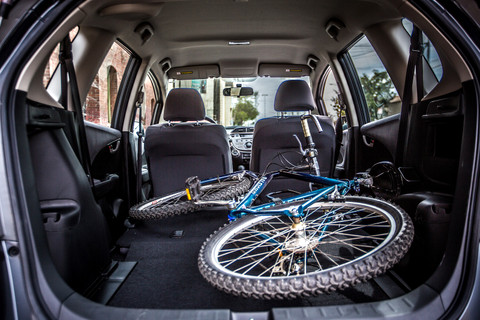
The 2018 Honda Fit is not shy with standard features. With a starting price of $17,080, including destination charges, the base LX with manual transmission includes full power accessories, a rearview camera, automatic headlights, cruise control, air conditioning, redundant steering wheel controls, tilt/telescoping steering wheel as well as Bluetooth, iPod integration and a USB port. Plus, a feature that no competitor offers, Honda’s Magic Seat.
Our 2018 Fit Sport posted a sticker price of $18,390. It had all of the exterior and interior upgrades mentioned above plus Apple CarPlay and Android Auto.
The top competitors, all with lower starting prices, are the Ford Fiesta, Hyundai Accent, Kia Rio, Nissan Versa Note. Only the Toyota Yaris is more expensive.
While it costs a little more, the 2018 Honda Fir is worth it. On a day-to-day basis, the 2018 Honda Fit performs its driving duties admirably. It scoots about town with little effort and when it hits the highways, has no problem keeping up with the flow. Where the Fit really shines is inside. Seating is comfortable, knobs and controls are easy to reach and operate, and that trick rear seat expands the already-generous cargo area to a space that rivals small crossover SUVs.
Related Stories You Might Enjoy—Other Subcompact Hatches
Flash Drive 2018 Kia Rio 5-Door
Road Test: 2015-toyota-yaris/
Road Test: 2014 Nissan Versa Note
Disclosure:
Clean Fleet Report is loaned free test vehicles from automakers to evaluate, typically for a week at a time. Our road tests are based on this one-week drive of a new vehicle. Because of this we don’t address issues such as long-term reliability or total cost of ownership. In addition, we are often invited to manufacturer events highlighting new vehicles or technology. As part of these events we may be offered free transportation, lodging or meals. We do our best to present our unvarnished evaluations of vehicles and news irrespective of these inducements.
Our focus is on vehicles that offer the best fuel economy in their class, which leads us to emphasize electric cars, plug-in hybrids, hybrids and diesels. We also feature those efficient gas-powered vehicles that are among the top mpg vehicles in their class. In addition, we aim to offer reviews and news on advanced technology and the alternative fuel vehicle market. We welcome any feedback from vehicle owners and are dedicated to providing a forum for alternative viewpoints. Please let us know your views at publisher@cleanfleetreport.com.

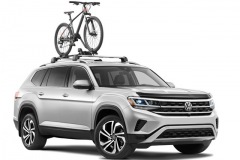
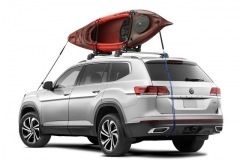

3 thoughts on “Road Test: 2018 Honda Fit Sport”